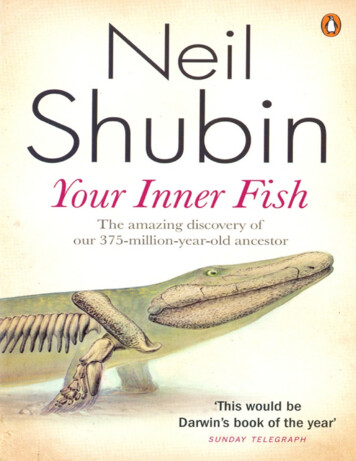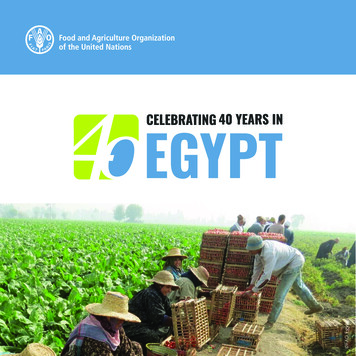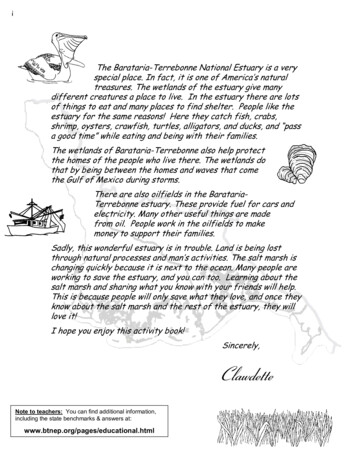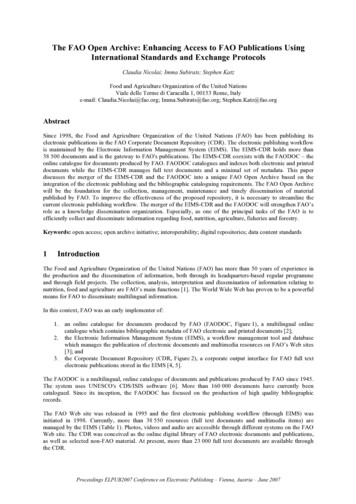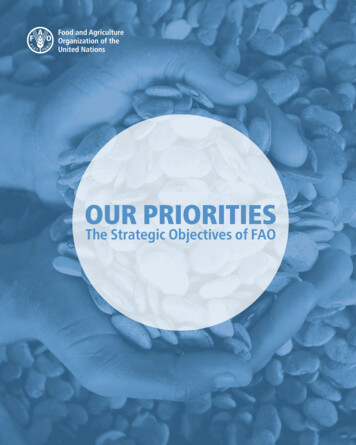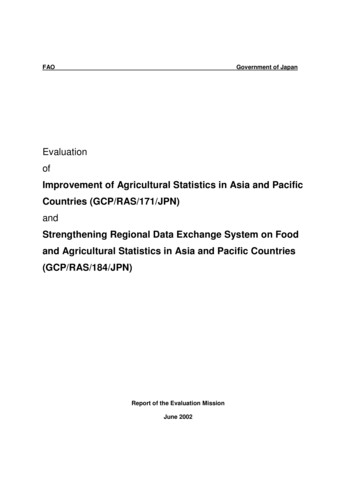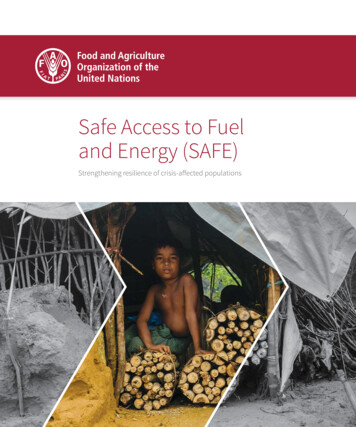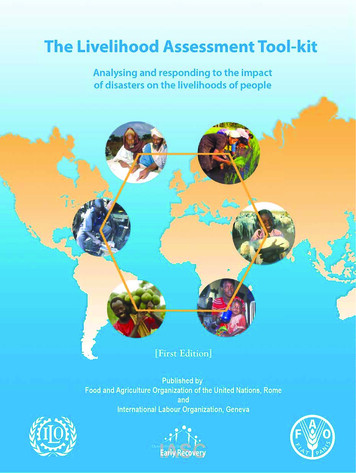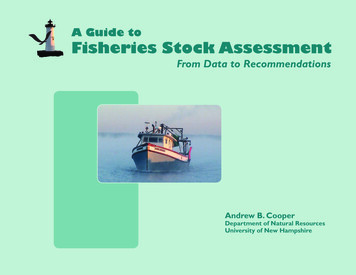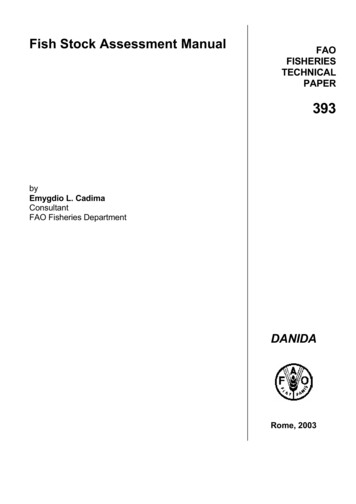
Transcription
Fish Stock Assessment ManualFAOFISHERIESTECHNICALPAPER393byEmygdio L. CadimaConsultantFAO Fisheries DepartmentDANIDARome, 2003
PREPARATION OF THIS DOCUMENTThe author, Emygdio Cadima, now retired, was an FAO scientist in the Fisheries Departmentuntil 1974, when he returned to the Instituto de Investigação das Pescas e do Mar (IPIMAR) inPortugal, having also been a Professor at the University of Algarve until 1997. At the end of1997 he was the lecturer of a course in Fish Stock Assessment in IPIMAR, which became thebasis for the preparation of this manual, requested and supported by the Project FAO/DANIDAGCP/INT/575/DEN. This manual also incorporates notes from courses in Fish Stock Assessmentheld at several different venues in the world, mainly in Europe, Latin America and Africa. Thesecourses had an active collaboration of fisheries scientists from all over the world, especiallyPortugal. These scientists are also co-responsible for the orientation, for the matters treated andparticularly for the elaboration of the exercises.This manual aims to present the basic knowledge on the problems and methods of fish stockassessment to young scientists, post-graduate students, and PhD students. This is a scientific areain permanent development, where the knowledge of fisheries biology is applied in order to makea rational and sustained exploitation of the fishing resources.The “Manual of Fish Stock Assessment” is mainly concerned with the theoretical aspects of themost used models for fish stock assessment. The practical application (i.e. the exercises solved ina spreadsheet), is considered as a complementary part to help the understanding of the theoreticalmatters.The editing of the manuscript was made by Siebren Venema, manager ofProject GCP/INT/575/DEN and Ana Maria Caramelo, Fishery Resources Officer in the FAOFisheries Department.Distribution:DANIDAFisheries Education InstitutesMarine Research InstitutesNational and International OrganizationsUniversitiesFAO Fisheries Departmentiii
Cadima, E.L.Fish stock assessment manual.FAO Fisheries Technical Paper. No. 393. Rome, FAO. 2003. 161p.ABSTRACTThe manual follows the same order of the lectures in the last course held in IPIMAR(November/December 1997). It starts with an introduction to the mathematical models applied inFish Stock Assessment and some considerations on the importance of fisheries. The need for arational management of the fishing resources is then stressed, this being indispensable for anadequate exploitation, aiming at conservation, to occur. The basic assumptions about a modeland the concepts of different variation rates of a characteristic in relation to time (or to othercharacteristics) are presented, highlighting the most important aspects of the simple andexponential linear models which are used in the chapters that follow. After some considerationson the concept of cohort, models for the evolution in time of the number and weight of theindividuals that constitute the cohort are developed, including models for the individual growthof the cohort. In the chapter concerning the study of the stock, the fishing pattern and itscomponents are defined, the most used models for the stockírecruitment relation are presented,as well as the short and long term projections of a stock. With regard to fishing resourcesmanagement, the discussion is focused on the biological reference points (target points, limitpoints and precautionary points) and fisheries regulation measures. The last chapter, whichpresents and discusses theoretical models of fish stock assessment, deals with production models(also designated as general production models) and with the long and short–term projections ofthe catches and biomasses. Finally, the general methods of estimating parameters are describedand some of the most important methods are presented, with special relevance to the cohortanalysis by age and length. Then a solution of the exercises from the last course held in IPIMAR,is presented by the author and the scientist Manuela Azevedo.iv
TO MY FIRST MASTERS AND OLD-TIME FRIENDSRay BevertonJohn GullandGunnar SætersdalPREFACEThis work is essentially orientated to present an introduction to the mathematical models appliedto fisheries stock assessment.There are several types of courses about the methods used in fish stock assessment.One type considers practical application as the main aspect of the course, including the use ofcomputer programs. The theoretical aspects are referred to and treated as complementaryaspects.A second type is mainly concerned with the theoretical aspects of the most used models. Thepractical application, considered as the complementary part, facilitates the understanding of thetheoretical subjects.In this work, the second type was adopted and exercises were prepared to be solved in aworksheet (Microsoft Excel). The table of contents indicates the exercises corresponding to eachsubject.This manual is the result of a series of courses on Fish Stock Assessment held in the followingplaces. Portugal : Instituto de Investigação das Pescas e do Mar – IPIMAR (ex-INIP) in Lisbon,Faculdade de Ciências de Lisboa, University of Algarve and Instituto de Ciências Biomédicas deAbel Salazar in Oporto. Other courses were held at Instituto de Investigação das Pescas in CapeVerde, at the Centro de Investigação Pesqueira in Angola, at the Instituto de Investigação dasPescas in Mozambique, at the Centro de Investigacion Pesquera – CIP in Cuba, at the Institutodel Mar del Perú – IMARPE in Peru, at the Instituto Español de Oceanografía – IEO (Vigo andMálaga – Spain). It is also a result of some lectures integrated into cooperation courses held inseveral countries and organized by FAO, by SIDA (Sweden), by NORAD (Norway) and byICCAT.Other fisheries scientists cooperated in these courses and they are also co-responsible for theorientation of the subjects studied and very particularly for the elaboration of the exercises andthe editorial work. With no particular criterium, these are some of the collaborators to whom Iexpress my appreciation: Ana Maria Caramelo, Manuel Afonso Dias, Pedro Conte de Barros,Manuela Azevedo Lebre, Raúl Coyula, Renato Guevara.Lisbon, December 1997E. Cadimav
CONTENTSGlossary of technical terms used in the TIONThe Importance of FisheriesFisheries Resources ManagementFisheries Resources ResearchFish Stock Assessment111232.2.12.22.32.4MODELS AND RATESModelsRatesSimple Linear ModelExponential Model66812143.3.13.23.33.43.53.63.7COHORTCohort – IntroductionEvolution of the number of a cohort, in an interval of timeCatch, in number, over an interval of timeIndividual GrowthBiomass and Yield, during the interval TiCohort during the exploitable lifeSimplification of Beverton and Holt18181923243132354.4.14.24.34.44.5STOCKStock over a one year periodFishing pattern over a one year periodShortíterm projections of the stockLongíterm projections of the stockStockírecruitment (SíR) relation4.6Relation between R and B (RíS relation)383841424246505.BIOLOGICAL REFERENCE POINTS AND REGULATIONMEASURESBiological reference points for the management and conservation offisheries resourcesBiological target reference points (Fmax, F0.1 , Fmed and FMSY)Biological limit reference points (Bloss, MBAL, Fcrash and Floss)Precautionary reference points – Fpa, BpaFisheries regulation measures5.15.25.35.45.5vii535355626364
CONTENTS6.6.16.26.36.46.56.66.76.8PRODUCTION MODELSBasic assumption about the evolution of the biomass of a non exploitedstockExploited stockVariation of the biomass in the interval TiPage67676768Long term projections (LT) (Equilibrium conditions)Biomass and fishing level indicesBiological target reference points (TRP)Types of production modelsShort term IMATION OF PARAMETERSSimple Linear Regression – Least squares methodMultiple Linear Regression – Least squares methodNon-linear model – Method of Gauss-Newton - Least squares methodEstimation of growth parametersEstimation of M – Natural mortality coefficientEstimation of Z – Total mortality coefficientEstimation of the parameters of the stock-recruitment (S-R) relationEstimation of the matrix [F] and of the matrix [N] – Cohort analyses –AC and al Revision1138.2Rates1158.3Simple linear model1168.4Exponential model1178.5Cohort – Evolution in number1188.6Cohort – Catch in number1198.7Individual growth in length and weight1218.8Cohort during all life – Biomass and catch in weight1248.9Cohort during its life – Simplification of Beverton and Holt model1268.10Stock – Short term projection127viii
CONTENTSPage8.11Stock – Long term projection1298.12Stock – Recruitment relation1318.13Fmax1328.14F0.11338.15Fmed and FMSY1348.16MBAL and Bloss1368.17Floss and Fcrash1378.181398.19Production models (equilibrium) – SchaeferProduction models (equilibrium) – Abundance and fishing levelindices8.20Production models – Short term projection1418.21Simple linear regression – Estimation of the parameters of theWíL relation and growth parameters (FordíWalford, Gulland and Holtand Stamatopoulos and Caddy)1428.22Multiple linear model – Revision of matrices – Estimation of theparameters of Fox integrated model (IFOX)1448.23Non linear regression – Estimation of the growth parameters and ofthe S–R relation (GaussíNewton method)1478.24Estimation of M1488.25Estimation of Z1508.26Age cohort analysis (CA)1528.27Length cohort analysis (LCA)1558.28Examination – Written test (Lisbon, Dec. 1997)158ix140
GLOSSARY OF TECHNICAL TERMS USED IN THE MANUALAbundance index (U) – A characteristic preferably proportional to the available biomass of theresource. The catch per unit effort, cpue (especially when the effort is expressed inappropriate units) is an important index.Biological Limit Reference Point (LRP) – Biological reference point indicating limits of thefishery exploitation with regard to stock self-reproduction, aiming at conservation of theresource.Biological Precautionary Reference Point (PaRP) – biomass levels (Bpa) and fishing levels(Fpa), established under the precautionary principle, concerning the reproduction of thestock, aiming at conservation of the resources. The assumptions and methods used todetermine the PaRPs should be mentioned.Biological Reference Point (BRP) – Values of F and B, taking into consideration the bestpossible catch and/or ensuring the conservation of the fishery resource. There are BRPsbased on long term projections (LP), BRPs based on values observed during a certainperiod of years and BRPs based on the two previous criteria. The BRPs can be TargetPoints (TRP), Limit-Points (LRP), and Precautionary Points (PaRP). In this manual thefollowing biological reference points are referred to: Fmax, F0.1, Fhigh, Fmed, FMSY, Floss,Fcrash, Bmax, B0.1, Bmed, BMSY, Bloss, MBAL. Other biological reference points, used inmanagement, like F30%SPR, are not mentioned in this manual.Biological Target Reference Point (TRP) – Biological reference point indicating long termobjectives (or targets), for the management of a fishery, taking into consideration the bestpossible catch and ensuring the conservation of the stock.Biomass (B) – Weight of an individual or a group of individuals contemporaneous of a stock.Capturability Coefficient (q) – Fraction of the biomass that is caught by unit of fishing effort.Carrying capacity (k) – Capacity of the environment to maintain the stock living in it. It is,theoretically, the limit of the non exploited biomass (see intrinsic gross rate of thebiomass, r).Catch in number (C) – Number of individuals caught.Catch in weight or Yield (Y) – Biomass of the stock taken by fishing. Yield does notnecessarily correspond to landed weight. The difference between the two values, yieldand landings, is mainly due to rejections to the sea of part of the catch which, for somereason (price, quality, space problems or even legal reasons), is not landed.Cohort – Set of individuals of a fishery resource born from the same spawning.Exploitation pattern of a gear (s) – Fraction of the individuals of a given size, available to thegear, which is caught. Also designated by Selectivity or partial recruitment.Individual growth coefficient (K) – Instantaneous relative rate of change of a function of theindividual weight, w, that is, H(w )-H(w), where w is the asymptotic individual weightand H(w) is a function of w (frequently a power function, including the logarithmicfunction). The adopted models for the function H(w) have two constants, w and K.Some models introduce one more parameter, b, which is used to obtain a general relationxi
to include the most common individual growth relations. The constant K has the physicaldimension of time –1.Individual Quota (IQ) – Quota attributed to a vessel.Individual Transferable Quotas (ITQ) – System of fisheries management characterized by thesale, at auctions, of the fishing annual vessel quotas.Minimum Biomass Acceptable Level (MBAL) – Biological reference limit point that indicatesa spawning biomass level under which the observed biomasses during a period of years,are small and the associated recruitments are smaller than the mean or medianrecruitment.Number of individuals of a cohort or of a stock (N) – Number of survivals of a cohort (or astock) at a certain instant or over an interval of time.Partial recruitment – (see exploitation pattern)Precautionary principle – This principle establishes that a lack of information does not justifythe absence of management measures. On the contrary, management measures should beestablished in order to maintain the conservation of the resources. The assumptions andmethods used for the determination of the scientific basis of the management should bepresented.Production models – Models that consider the biomass of the stock as a whole, that is, they donot take into consideration the age or size structure of the stock. These models are onlyapplied in analyses that consider fishing level changes, as they do not allow the analysisof the effects of changes in the exploitation pattern, on catches and biomasses.Quota (Q) – Each of the fractions in which the TAC was divided.RATESAbsolute Instantaneous Rate of y, air(y) – Velocity of the variation of the function y(x), at theinstant x.Absolute Mean Rate of y, amr(y) – Mean velocity of the variation of the function y(x), duringa certain interval of x.Annual Survival Rate (S) – Mean rate of survivals of a cohort during one year, relative to theinitial number.Exploitation Rate (E) – Ratio between the number of individuals caught and the total number ofindividuals dead, over a certain period of time, that is, E C/D.Fishing mortality instantaneous rate (F) (Fishing mortality coefficient) – Relativeinstantaneous rate of the mortality of the number of individuals that die due to fishing .Intrinsic rate of the biomass growth (r) – Constant of the Production models that representsthe instantaneous rate of the decreasing of the function H(K)-H(B), where B is thebiomass, H(B) is a function of the total biomass, usually a power-function, (including thelogarithmic function that can be considered a limit power function) and k is the carryingcapacity of the environment. Some models introduce one more parameter, p, which isused to obtain a more general relation.xii
Natural mortality instantaneous rate (M) (Natural mortality Coefficient) – Instantaneousrelative rate of the mortality of the number of individuals that die due to all causes otherthan fishing.Relative instantaneous rate of y, rir(y) – Velocity of the variation of the function y(x), relativeto the value of y, at the instant x.Relative mean rate of y, rmr(y) – Mean velocity of the variation of the function y(x) relative toa value of y, during a certain interval of x.Total mortality instantaneous rate (Z) (Total mortality coefficient) – Relative instantaneousrate of the mortality of the number of individuals that die due to all causes. Z, F and Mare related by the following expression : Z F M .Recruitment to the exploitable phase (R) – Number of individuals of a stock that enter thefishery area for the first time each year.Selectivity – (see exploitation pattern)Spawning or adult biomassa (SP) – Biomasss of the stock (or of a cohort) which has alreadyspawned at least once.Stock – Set of survivals of the cohorts of a fishery resource, at a certain instant or period of time.It may concern the biomass or the number of individuals.Stock-Recruitment (S-R) relation – Relation between the parental stock ( spawning biomass)and the resulting recruitment (usually the number of recruits to the exploitable phase).The models have two constants, α and k. The constant k has the physical dimension ofweight and α has the dimension of weight-1. Some models introduce one moreparameter, c, which is used to obtain a general relation that includes the most commonrelations.Structural models – Models that consider the structure of the stock by ages or sizes. Thesemodels allow one to analyse the effects on catches and biomasses, due to changes in thefishing level and exploitation pattern.Total Allowable Catch (TAC) – Management measure that limits the total annual catch of afishery resource, aiming to indirectly limit the fishing mortality. The TAC can be dividedinto Quotas (Q) using different criteria, like countries, regions, fleets or vessels.Total number of deaths (D) – Total number of individuals that die during a certain period oftime.Virgin biomass (VB) – Biomass of the stock not yet exploited.xiii
SYMBOLSSymbolsIndicating :AConstant of the simple linear model (intercept of the straight line )αConstant of the Stock-Recruitment relations (limit value of R/S when S 0)amr(y)Absolute mean rate of variation of yair(y)Absolute instantaneous rate of variation of yBConstant of the simple linear model (slope of the straight line)BBiomassSP, SBSpawning BiomassCCatch, in numberCConstant of the Stock-Recruitment relations (generalizes the models)DTotal number of deathsEExploitation rateFFishing mortality coefficientCconstNon defined constantCteNon defined constantHGeneral power functionITQIndividual Transferable QuotasKConstant of the individual growth models (associated to growth rate)kConstant of the Stock-Recruitment relationskConstant of the production models (Carrying capacity)L,LTotal length of an individualMBALMinimum Biomass Acceptable Level (biological reference limit point)MNatural mortality coefficientNNumber of individuals of a cohortPConstant of the Production models (generalizes the models)QCapturability coefficientRConstant of the Production models (intrinsic rate associated with the biomassgrowth)R2Determination coefficientRRecruitment to the exploitable phasermr(y)Relative mean rate of variation of yrir(y)Relative instantaneous rate of variation of yxiv
SymbolsIndicating :SAnnual Survival rateSAdult or total biomass (in the relations S-R)sExploitation pattern (selectivity)SQSum of the squares of the deviationsS-RStock-Recruitment relationtInstant of timeTInterval of time between 2 instantsTACTotal Allowed CatchTRPBiological Target Reference PointUStock abundance indexVFunction to be maximized for the determination of F0.1WIndividual weightYCatch in weightZTotal mortality coefficient (total mortality instantaneous rate)xv
SUBSCRIPTSThe characteristics of this glossary are usually shown with indices; that is why it was considerednecessary to present the meaning of those subscripts.SubscriptsIndicating : Economical value of the respective characteristic of the cohortλMaximum age0.1Value of F (and of other characteristics of the cohort) corresponding to theair of the biomass equal to 10 percent of the virgin biomasscRecruitment to exploitable phasecrashValue of F which, at long term, corresponds to the collapse value of thespawning biomassEValue of the characteristics of the cohort corresponding to an equilibriumpointiAgeinflValue of the characteristic corresponding to an inflection point of anyrelation between that characteristic and other variable.lLengthlimValue of B or of F corresponding to a biological reference limit pointlossValue of B or of F corresponding to the minimum spawning biomassobservedMaxValue of F (and of other characteristics of the cohort) where the yield perrecruit is maximumMedValue of F (and of other characteristics of the cohort) which, at long term,will produce a spawning biomass per recruit equal to the median value of thespawning biomasses per recruit observed during a certain period of yearsMSYValue of F (and of other characteristics of the stock) where the long termtotal yield is maximumRRecruitment to the exploitable phasexvi
BIBLIOGRAPHYBertalanffy, L. Von 1938. A quantitative theory of organic growth. Hum. Biol., 10 (2): 181-213.Beverton, R.J.H. & Holt, S.J. 1956. On the dynamics of exploited fish populations. U.K. Min.Agric. Fish., Fish. Invest (Ser. 2) 19: 533p.Caddy, J.F.& Mahon, R. 1995. Reference points for fishery management. FAO Fish. Tech. Pap.349: 80p.Cadima, E. 1991. Some relationships among biological reference points in general productionmodels. ICCAT, Coll. Vol. Sc. Papers, (39):27-30.Cadima, E. & Pinho, M.R. 1995. Some theoretical considerations on non equilibrium productionmodels. ICCAT, Coll. Vol. Sc. Papers, (45):377-384.Cadima, E. & Palma, C. 1997. Cohort analysis from annual length catch compositions. WDpresented to the Working Group on the assessment of the Southern Shelf DemersalStocks. Copenhagen, 1-10 September, 1997.Cadima, E. & Azevedo, M. 1998. A proposal to select reference points for long term fisherymanagement objectives. ICES,C.M. 1998/T:9, 18p.Cardador, F. 1988. Estratégias de exploração do stock de pescada, Merluccius merluccius L., daságuas Ibero-Atlânticas. Efeitos em stocks associados. Dissertação apresentada paraprovas de acesso à categoria de Investigador Auxiliar. IPIMAR (mimeo)CE 1994. Report of the southern hake task force. Lisbon, 10-14 October, 1994.Clark, W.G. 1991. Groundfish exploitation rates based on life history parameters. Can. J. Fish.Aquat. Sci., 48: 734-750.Clark, W.G. 1993. The effect of recruitment variability on the choice of target level of spawningbiomass per recruit. pp 233-246 In: Kruse, G.; Eggers, D.M.; Marasco, R.J.; Pautzke, C.& Quinn, T.J. (eds.). Proceedings of the International Symposium on ManagementStategies for Exploited Fish Populations. Alaska Sea Grant College Program ReportNº 93-02, Fairbanks, University of Alaska.Cushing, D.H. 1996. Towards a science of recruitment in fish populations. In: Excelence inEcology, Book 7, Ecology Institut, Oldendorf/Scuhe, Germany.Deriso, R.B. 1980. Harvesting strategies and parameter estimation for an age-structured model.Can. J. Fish. Aquat. Sci., 37: 268-282.Duarte, R; Azevedo, M. & Pereda, P. 1997. Study of the growth of southern black and whitemonkfish stocks. ICES J. mar. Sci., 54: 866-874.FAO 1995. Code of Conduct for Responsible Fisheries, Rome, FAO, 41p.FAO 1996. Precautionary approach to fisheries. FAO Fish. Tech. Pap. 350 (2): 210p.Ford, E. 1933. An account of the herring investigations conducted at Plymouth during the yearsfrom 1924-1933. J. Mar. Biol. Assoc., N.S., 19: 305-384.Fox, W.W. Jr 1970. An exponential surplus-yield model for optimizing exploited fishpopulations. Trans. Am. Fish Soc., 99: 80-88.Garrod, G.J. 1969. Empirical assessment of catch/effort relationships in the North Atlantic codstocks. Res. Bull ICNAF, 6: 26-34.xvii
Gompertz, B. 1825. On the nature of the function expressive of the law of human mortality, andon a new mode of determining the value of life contingencies. Phil. Trans. Royal Society,115 (1): 513-585.Gulland, J.A.1959. Fish Stock Assessment: A manual of basic methods. FAO/Wiley series,223p.Gulland, J.A. 1969. Manual of Methods for Fish Stock Assessment - Part 1. Fish PopulationAnalysis. FAO Manuals in Fisheries Science No. 4.Gulland, J.A. 1983. Fish stock assessment A manual of basic methods. FAO/Wiley Ser. on Foodand Agriculture, Vol 1: 233 pp.Gulland, J.A. & Boerema, L.K 1973. Scientific advice on catch levels. Fish.Bull. 71 (2):325-335Gulland, J.A. & Holt, S.J. 1959. Estimation of growth parameters for data at unequal timeintervals. J. Cons. ICES, 25 (1): 47-49.Gunderson, D.R. 1980. Using r-K selection theory to predict natural mortality. Can. J. FishAquat. Sci. 37: 2266-2271.Hilborn, R. & Walters, C.J. 1992. Quantitative Fisheries Stock Assessment: Choice, Dynamicsand Uncertainty. New York, Chapman and Hall, 570p.ICES 1996. Report of the Northern Pelagic and Blue Whiting Fisheries Working Group. Bergen,23-29 April 1996. ICES CM 1996/Assess:14ICES 1997a. Report of the Working Group on the Assessment of Southern Shelf Demersal Stocks.Copenhagen, 3-12 September 1996. ICES CM 1997/ASSESS:5ICES 1997b. Report of the Working Group on the Assessment of Mackerel, Horse Mackerel,Sardine and Anchovy. Copenhagen, 13-22 August 1996. ICES CM 1997/ASSESS:3ICES 1997c. Report of the Working Group on the Assessment of Southern Shelf Demersal Stocks.Copenhagen, 3-12 September 1996. ICES CM 1997/ASSESS:5ICES 1997d. Report of the Comprehensive Fishery Evaluation Working Group. Copenhagen,25 June - 04 July 1997. ICES CM 1997/ASSESS:15.ICES 1998a. Report of the Study Group on the Precautionary Approach tro Fisheries Management.Copenhagen, 3-6 February 1998. ICES CM 1998/ACFM: 10ICES 1998b. Report of the Working Group on the Assessment of Mackerel, Horse Mackerel,Sardine and Anchovy. Copenhagen, 9-18 September 1997. ICES CM 1998/ASSESS:6ICES 1998c. Report of the Working Group on the Assessment of Southern Shelf Demersal Stocks.Copenhagen, 1-10 September 1997. ICES CM 1998/ASSESS:4ICES 1998d. Report of the Working Group on the Assessment of Northern Shelf Demersal Stocks.Copenhagen, 16-25 June 1997. ICES CM 1998/ASSESS:1Jones, R. 1961. The assessment of the long term effects of changes in gear selectivity and fishingeffort. Mar. Res. Scot., 2, 19p.Jones, R. & van Zalinge, N.P. 1981. Estimates of mortality rate and population size for shrimp inKuwait waters. Kuwait Bull. Mar. Sci., 2: 273-288.Lotka, A.J. 1925. The Elements of Physical Biology. Baltimore, Williams and Wilkins.xviii
Marquardt, D.W. 1963. An algorithm for least squares estimation of non-linear parameters.J. Soc. Ind. Appl. Math., 2: 431-441.Mattos e Silva, G.O. 1995. Aplicação de modelos de produção geral em condições de nãoequilíbrio para a avaliação do manancial de gamba Parapenaeus longirostris (Lucas,1846) da costa sul portuguesa. Dissertação apresentada para obtenção do grau de Mestreem Estudos Marinhos e Costeiros. UAL, Unidade de Ciências e Tecnologias dosRecursos Aquáticos, Faro, 96p.Megrey, B. 1989. Review and comparison of age-structured stock assessment models fromtheoretical and applied points of view. Am. Fish. Soc. Symp., 6: 8-48.Paloheimo, J.E. 1961. Studies on estimation of mortalities. Comparison of a method describedby Beverton and Holt and a new linear formula. J. Fish. Res. Bd. Can., 18 (5): 645-662.Pauly, D. 1980. On the interrelationships between natural mortality, growth parameters andmean environmental temperature in 175 fish stocks. J. Cons. Int. Explor. Mer, 39: 175192.Pella, J.J. & Tomlinson, P.K. 1969. A generalized stock production model. Bull. Inter. Am. Trop.Tuna Comm., 13: 419-496.Pestana, G. 1989. Manancial Ibero-Atlântico de sardinha, Sardina pilchardus, Walb., suaavaliação e medidas de gestão. Dissertação original para provas de acesso à categoria deInvestigador Auxiliar. IPIMAR, 192p. (mimeo).Pope, J.G. 1972. An investigation of the accuracy of virtual population analysis using cohortanalysis. Res. Bull. ICNAF, 9: 65-74.Prager, M.H. 1994. A nonequilibrium surplus-production model. Fish. Bull. 92 (2): 372-389Prager, M.H. 1995. User s Manual for ASPIC: a stock-production model incorporatingcovariates, program version 3.6x. Miami Lab. Doc. MIA-92/93-55Richards, F.J. 1959. A flexible growth function for empirical use. J. Exp. Bot., 10: 290-300.Ricker, W.E. 1954. Stock and recruitment. J. Fish. Res. Bd. Can., 11: 559-623.Ricker, W.E. 1958. Handbook of computation for biological statistical of fish population. Bull.Fish. Res. Bd. Can., 119: 300p.Ricker, W.E. 1969. Effects of size-selective mortality and sampling bias on estimates of growth,mortality, production and yield. J. Fish. Res. Bd. Can., 26: 479-541.Ricker, W.E. 1975. Computation and interpretation of biological statistics of fish population.Bull. Fish. Res. Bd. Can., 191: 382pRikhter, J.A. & Efanov, V.N. 1976. On one of the approaches to estimation of natural mortalityof fish population. ICNAF 76/VI/8, 12p.Rosenberg, A.A.; Kirkwood, G.P.; Crombie, J.A. & Beddington, J.P. 1990. The assessment ofstocks of annual squid species. Fish. Res. 18:335-350.Sætersdal, G. 1984. Investigação, gestão e planificação pesqueiras. Revista de InvestigaçãoPesqueira, 9. Instituto de Investigação Pesqueira. Maputo. R.P.M.: 167-186.Schaefer, M. 1954. Some aspects of the dynamics of populations important to the managementof the commercial marine fisheries. Bull. Inter. Am. Trop. Tuna Comm., 1 (2): 27-56.xix
Shepherd, J.G. 1982. A versatile new stock-recruitment relationship for fisheries, and theconstruction of sustainable yield curves. J. Cons. Int. Explor. Mer, 40 (1): 67-75.Sparre, P. & Venema, S.C. 1997. Introdução à avaliação de mananciais de peixes tropicais. FAODoc. Téc.Pescas, 306/1 Rev 2. (Parte 1 & 2): 404 & 94 pp.Stamatopoulos, C. & Caddy, J.F. 1989. Estimation of Von Bertalanffy growth parameters: aversatile linear regression approach. J. Cons. Int. Explor. Mer, 45: 200-208.Tanaka, S. 1960. Studies on the dynamics and the management of fish populations. Bull. Tokai.Reg. Fish. Res. Lab., 28: 1-200.Volterra, V. 1928. Variations and fluctuations of the number of individuals in animal speciesliving together. J. Cons. Int. Expl. Mer, 3 (1): 3-51.Yoshimoto, S.S. & Clarke, R.P. 1993.
Fish Stock Assessment Manual by Emygdio L. Cadima Consultant FAO Fisheries Department FAO FISHERIES TECHNICAL PAPER 393 DANIDA Rome, 2003. iii PREPARATION OF THIS DOCUMENT The author, Emygdio Cadima, now retired, was an FAO scientist in the Fisheries Department until 1974, when he returned to the Instituto de Investigação das Pescas e do Mar (IPIMAR) in Portugal, having also been a Professor .
